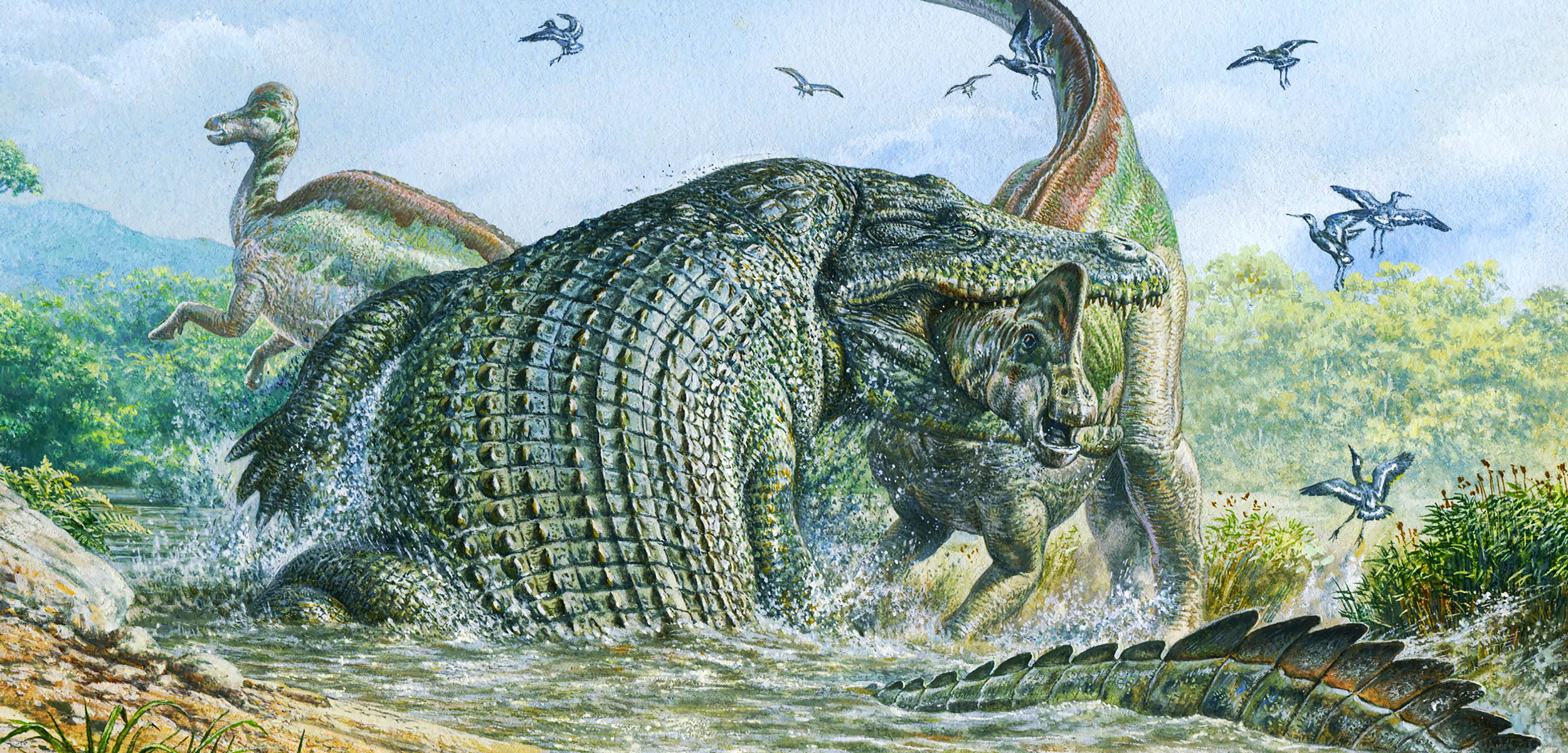When Deinosuchus Ruled the Earth
As long as T. rex but twice as heavy, this ancient alligator makes for terrifying nightmares. Now, a new study reveals there wasn’t just one Deinosuchus species, but three.
Article body copy
More than 75 million years ago, a formidable carnivore lurked in the coastal swamps of North America. This ancient behemoth was not a dinosaur, but a 10-meter-long alligator that weighed up to seven tonnes—as much as a full-grown elephant. With its snapping jaws, Deinosuchus was the largest predator of its ecosystem, and it made snacks out of the duckbills and horned dinosaurs that plodded near prehistoric marshes.
Despite its menacing stature, Deinosuchus has largely remained an armor-encased mystery since William Jacob Holland first discovered its bones in Montana in 1909. No skull—much less a complete skeleton—had yet been found. All the same, researchers have remained fascinated with the enormous reptile. In 1954, Edwin Colbert and Roland Bird of New York’s American Museum of Natural History pieced together a plaster-and-fossil model of the ancient reptile using what bones they had found, filling in missing parts with the anatomy of modern Cuban crocodiles. Over time, paleontologists assigned various Deinosuchus fossil discoveries to a single species, Deinosuchus hatcheri, and dubbed the animal an ancient member of the croc subgroup that contains modern alligators and caimans. The sheer enormity of the alligator—and the fact that it was often presented in museums with jaws agape as if ready to snatch up a visitor—made it a fossil legend.
But according to a new study, what was once thought to be one species may have been as many as three terrifying species. That’s the conclusion reached by paleontologists Adam Cossette and Christopher Brochu, from the New York Institute of Technology and the University of Iowa, respectively, after puzzling together hundreds of Deinosuchus fossils—including newly excavated specimens—collected from more than 10 states over the past century.
Scientists had previously identified anatomical idiosyncrasies between various Deinosuchus finds, but chalked those up to mere variations on a single species. Cossette and Brochu, however, found they were indicative of different animals entirely. “We used the largest number of specimens to date, and we determined that three species of Deinosuchus existed in the fossil record,” says Cossette. For duckbills and other herbivores, that meant contending with a whole slew of swamp-bound chompers.
The finding parallels other research on living crocodilians. “We used to think that there was only one species of Nile crocodile,” says University of Tennessee, Knoxville, paleontologist Stephanie Drumheller-Horton who was not part of the new study. But genomic sequencing revealed that there are really two distinct species. Though Deinosuchus is too old for DNA to have been preserved, paleontologists can still pore over fine anatomical details to distinguish one species from another.
The latest research also confirms that, unlike the 1950s reproductions of Colbert and Bird, the three Deinosuchus species wouldn’t have looked like any crocodilian swishing around in today’s swamps.
“The animal’s snout was both long and wide, and had an inflated end around the nose,” Cossette says, making it appear as if someone had stretched out the muzzle of an American alligator. Not to mention that, in addition to its nasal passages, Deinosuchus had a pair of cavernous holes at the tip of its snout. What purpose they served is an enigma, but some scientists believe they could have played a role in the reptile’s sinuses, or in keeping its skull lightweight.
Why these reptiles grew so stupendously—matching Tyrannosaurus rex by length, but outweighing it two times over—is another mystery scientists are hoping to answer.
Deinosuchus spent most of its time in water, which may have freed it from size restrictions imposed by gravity on land, says Cossette. Drumheller-Horton also suspects that the plethora of prey such as turtles and three-tonne hadrosaurs had something to do with their sheer enormity.
The predators’ success, says Drumheller-Horton, may have hinged on the fact that they were so large that there was little they couldn’t crush between their jaws. Dinosaur bones marked by Deinosuchus teeth are a testament to this prowess.
“Deinosuchus would have been an opportunistic predator,” she says. “At their maximum sizes, that made almost everything else in their ecosystem a potential meal.”

